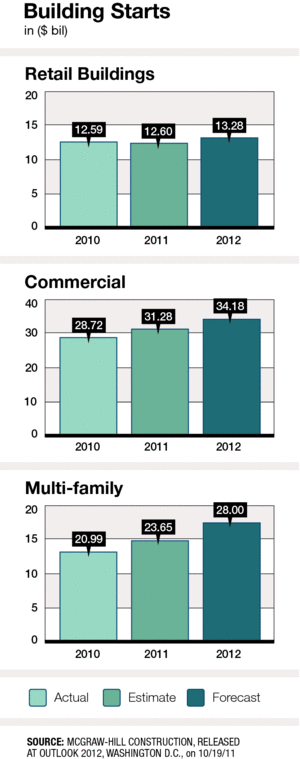

With the retail sector languishing, American developers are clinging to the renewed demand for construction of office and apartment buildings.
Providing modest relief, the sector movement is a result of converging market factors, including historically low vacancy rates in offices and a backlog in apartment units, as demand catches up to low levels of investment in recent years, developers say.
“There is a strong market in Washington, D.C., in particular, for opportunities to develop office properties,” says Jeff Linton, communications director and officer at New York City-based Forest City Enterprises Inc.
Linton sees pent-up demand from the vagaries of market forces and urban planning codes. For the past two years, he says, investors have been waiting out the recession. Also, building height restrictions in Washington, D.C., remain in effect. Both are creating demand in the city for office space, he notes.
Analysts say starts for offices began climbing in the second half of 2011 on historically low vacancy rates following the construction doldrums of the past three years, yielding growing demand for office space in major regional markets such as the D.C. area and New York City.
“At this point in the year, there has been more new leasing activity than we had at midyear 2006 and 2007, which were two extremely strong years,” says Maria Sicola, executive managing director and head of Americas research for New York City-based market anaylst Cushman & Wakefield.
“If activity continues at this pace, 2011 will be on track [to be] a historic year,” Sicola says. Cushman & Wakefield's midyear 2011 report for office markets shows the overall average office vacancy rate fell to 13.9 % from 14.6 % at the end of the first quarter of this year.
Markets in Miami, New York City and Washington, D.C., represent the strongest demand for new office projects. Sicola says the decline in vacancy rates is the result of new leasing activity, which is up 43.9 % from midyear 2010 levels with 42 million sq ft in new office leases signed so far this year.
Spurred by the low vacancy rates in the office market, new projects range from high-rise towers in the very fertile New York City and Miami markets to smaller mixed-use office development projects, such as Dallas-based Jackson-Shaw's $23-million Vista Point South, a 207,953-sq-ft complex in Coppell, Texas, consisting of six flex-office buildings.
“There is a significant amount of investor interest in a product like Vista Point South,” says Steve Golding, president and chief operating officer of Jackson-Shaw. Vista Point South is designed for maximum flexibility of use to accommodate diverse office tenants and changing market demands. Currently, in the highly competitive markets, he says, investors are looking for projects that are “well located, well designed and well constructed.”
Lenders Take Cautious Approach
Credit remains tight, but lenders and investors are moving on “well-sponsored projects in strong markets,” says Linton. After months of recession, lenders are willing to finance projects, but they require that “70% to 80% of leases be in place first,” he says.

Post a comment to this article
Report Abusive Comment